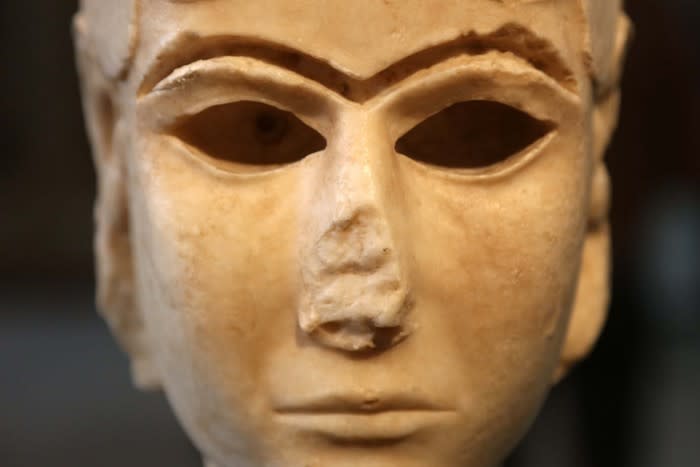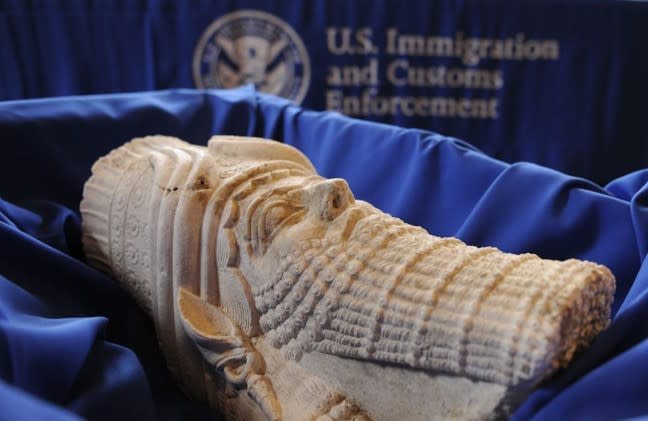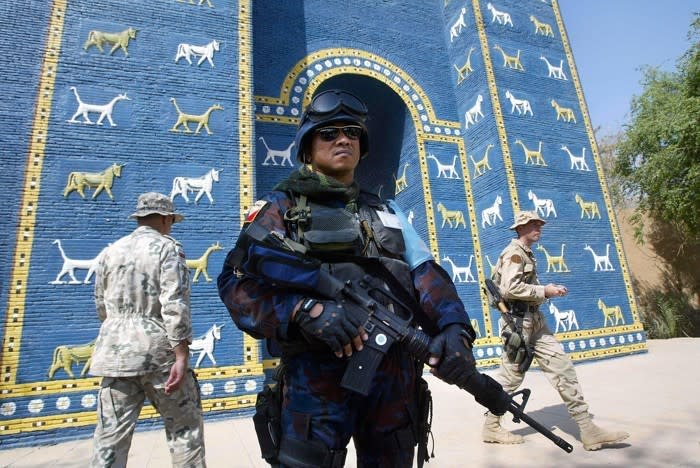It’s Disturbingly Easy to Buy Iraq’s Archeological Treasures
She can’t remember the exact date of her kidnapping. But it was springtime when the blur of bodies burst into her home, breaking first the silence, then the stone and glass. Someone rushed at her with outstretched hands, grabbed her head, and pulled. She was whisked outside—brief breeze of warm spring air!—then stuffed into a car. A man carried her to the back of a farm and buried her. It was months before the dirt above her face began to shift. Another pair of hands grabbed her head and pulled. Again outside—autumn air this time. Again into a car. Out the window Baghdad appeared, and then, at last, her home: the National Museum of Iraq.
This is the story of the Lady of Warka, also known as the Mona Lisa of Mesopotamia. A priceless Sumerian artifact dating back to 3100 B.C., it’s the earliest known representation of the human face. It was looted from the museum in Baghdad—along with 15,000 other antiquities—in the chaotic aftermath of the U.S. invasion of Iraq. Soon after, a tip from an Iraqi informant led American and Iraqi investigators to raid a nearby farm. They found the Lady of Warka intact. In September 2003, it was returned to the museum.
Recommended: What Were We Doing In Iraq Anyway?
Other artifacts have not been as lucky. Fifteen years after U.S. forces toppled Saddam Hussein, ushering in a period of instability that led to the plunder of the museum while ignoring pleas to secure the building, some 7,000 looted items have been returned, but about 8,000 are still out there. And that’s only counting the items that were stolen from the museum. After the invasion, thousands of other artifacts were taken directly out of the ground at archeological sites. In most cases, their whereabouts are unknown.

But experts have noticed an uptick in the availability of ancient Mesopotamian artifacts at online retailers since the 2003 invasion of Iraq. Now, anyone with broadband and a bit of spare cash can buy one of these artifacts. It’s likely, however, that at least some of the post-2003 internet wealth of Mesopotamian treasures is actually stolen goods. Although a UNESCO convention requires proper certification for objects excavated and exported after 1970, auction websites generally don’t require sellers to make this certification available upfront to prospective buyers.
Recommended: Photos: Looking Back at the War in Iraq, 15 Years After the U.S. Invaded
On the website Live Auctioneers, you can find a stone bull for $50, a clay cylinder seal for $150, a terracotta fragment bearing a god on a chariot for $225, and a large terracotta female idol for $400. On another auction site, Trocadero, a lion-shaped stone amulet is on offer for $250. The point is not that these particular artifacts were looted after the U.S. invasion, but that ancient Mesopotamian objects are very easy to buy online. And it’s extremely hard nowadays to know whether the provenance listed by the seller is accurate—and hence, whether the object has been legally sourced. Both these websites, in their terms of use, forbid users from posting false information, but neither responded to requests for clarifications about how this policy is enforced. Live Auctioneers’ terms prohibit law-breaking, but specify that the site has “no control over the quality, safety, or legality of the items advertised” and cannot guarantee “the truth or accuracy of the listings.” Trocadero notes that it “is not in a position to assume any duty or responsibility to veto reproductions or misrepresentations.”
“It is so, so easy to fake the provenance,” said Oya Topçuoğlu, a lecturer at Northwestern University who specializes in Mesopotamian archeology. “You can say, ‘My grandfather bought this when he visited the Middle East in 1928 and it’s been sitting in our attic since then.’ Or ‘This belongs to the collection of a Swiss gentleman who bought it in the ’50s.’ No one can prove otherwise, and no one will be any the wiser.”
In her recent study of Live Auctioneers, Topçuoğlu discovered that the majority of the items listed on the site are being sold out of London, which has long been a hub for trade in Mesopotamian artifacts. But, she explained, it’s very hard to prove that any given item was looted from the National Museum of Iraq, partly because many of the items stolen from the museum’s storage facility hadn’t yet been inventoried and numbered. “None of the things I’ve seen on Live Auctioneers—and I’ve looked at approximately 2,000 seals that were offered over the last 10 years—have museum numbers on them,” she said. “But the other thing is, you’re really limited to what the seller puts up on the website as a photograph. You don’t have the option to turn it around and look at it from every imaginable angle.”
Iraqi archeologist Abdulameer Al-Hamdani noted that, whereas you might find artifacts selling for $400 online, the properly documented artifacts he encounters tend to sell for closer to $400,000. It’s not that the cheaper ones are counterfeits; alarmingly, they tend to be real. “These Iraqi antiquities are very cheap because people want to get rid of them,” he said. “Maybe because they don’t have documentation for them.”
Recommended: The Iraq War and the Inevitability of Ignorance
Most of the Iraqi antiquities sold online are small. Of the large items stolen from the museum in 2003, the majority have been returned. Many Iraqis who looted these items quickly realized they couldn’t sell them because they were too recognizable, and took advantage of the amnesty that the museum offered for anyone returning stolen goods. Some iconic items were swept up in raids or got caught at customs as smugglers tried to export them.
The U.S. has helped recover and repatriate some of these. A stone statue of the Sumerian king Entemena of Lagash, which weighs hundreds of pounds and is missing its head, was stolen from Baghdad soon after the invasion. A clandestine operation involving federal prosecutors in New York led its recovery in 2006 and its return to Iraq in 2010. Another high-profile case centered on a limestone statue—this one consisting of nothing but a head—of the Assyrian king Sargon II. The artifact was seized in New York in 2008 and returned to Iraq in 2015. (Like London, New York is a major hub for the antiquities market, given the city’s many galleries and auction houses.)

Although the U.S. has been actively repatriating artifacts—Immigration and Customs Enforcement returned more than 1,200 items between 2008 and 2015 alone—it has also let some things slide. “It is worth noting that there were no follow-up congressional hearings or independent investigations to pinpoint the parties responsible for the negligence connected to the museum debacle,” Archeology Magazine reported in 2013. What’s more, as the Chicago Tribune reported in 2015, “American military members, contractors, and others caught with culturally significant artifacts they brought home from the war there largely aren’t prosecuted.” It’s not known how many Americans brought home artifacts as souvenirs or war trophies, but one expert suggested to the Tribune that the known cases—a defense contractor who brought back gold-plated items from Saddam’s palaces; a U.S. employee who shipped home an Iraq government seal; a Marine who bought eight ancient looted stone seals off the street—are just “the tiniest tip of the iceberg.”

The invasion didn’t take a toll only on Iraq’s movable artifacts; it also damaged the archeological sites from which such artifacts emerge. “It’s mostly the sites in the south that were damaged in the immediate aftermath of the invasion,” said Elizabeth Stone, an archeologist who used high-resolution satellite imagery to compare the damage to sites right before and after the invasion. Her data showed a sudden “massive devastation:” Of 1,457 southern sites examined, 13 percent had already been looted prior to the invasion, by February 2003—but that proportion rose to 41 percent by the end of the year. Sites containing relics of temples and palaces, like Umma and Umm Al-Aqarib, were far removed from governmental oversight, “so lots of people just went off and dug holes,” she said.
Al-Hamdani, a member of the Iraqi State Board of Antiquities and Heritage, was working at the Nasariyah Museum in the south when the U.S. invaded. One day he showed up at work to find that Marines had taken over the museum as headquarters. After several tense days, he persuaded them to join him in patrolling the nearby archeological sites. The amount of looting was incalculable. “We don’t know how many artifacts have been looted from there—that’s the hidden story,” he told me, before casually adding, “I myself was able to restore almost 30,000 stolen artifacts from the hands of the looters and smugglers, between 2003 and 2006.” He said he did this by working first with American and then with Italian forces, conducting patrols and raids. But if he was able to restore 30,000 artifacts, how many more thousands must have slipped through his fingers?
The looting, Al-Hamdani said, was clearly precipitated by the invasion. The war forced archeologists to stop work at their sites and leave behind hundreds of impoverished locals whom they’d trained and employed as excavators. Desperate and out of work, these locals began to earn an income the only way they knew how: by excavating—and selling their finds. Meanwhile, looters spread the word that a religious fatwa had been issued saying that it was permissible to steal and sell non-Islamic antiquities, especially if the money was used to fund an insurrection against the U.S. This was a lie: No such religious ruling had been issued. To combat the fictional fatwa, Al-Hamdani had to go to the revered Grand Ayatollah Al-Sistani and convince him to write a real fatwa forbidding looting from archeological sites.

But even aside from looting, some of the Iraqi artifacts that stayed in the country were badly damaged by the U.S. invasion. The Babylonians’ famous Ishtar Gate, built in 575 BC south of Baghdad and excavated in the early 1900s, offers a stark example. In 2003, U.S. forces established a military camp right in the middle of the archeological site. A 2004 study by the British Museum documented the “extremely unfortunate” damage this caused. About 300,000 square meters were covered with gravel, contaminating the site. Several dragon figures on the Ishtar Gate were damaged. Trenches were cut into ancient deposits, dispersing brick fragments bearing cuneiform inscriptions. One area was flattened to make a landing pad for helicopters; another made way for a parking lot; yet another, portable toilets.
“It is regrettable that a military camp of this size should then have been established on one of the most important archaeological sites in the world,” the study noted. “This is tantamount to establishing a military camp around the Great Pyramid in Egypt or around Stonehenge in Britain.”
To say it’s “regrettable” is an understatement to someone like Al-Hamdani, who noted that because civilization got its start in Mesopotamia, its archeological heritage represents the origins not only of Iraqis, but of all people. Wrecking that, he said, amounts to “looting the memory of humankind.” Yet he was optimistic that his native country will eventually get its stolen treasures back. “The international community,” he said, “wants to help Iraq recover the artifacts.”
But Topçuoğlu, who has watched what she suspects are looted Iraqi artifacts get scooped up online for a few bucks a pop, said, “I really don’t think we’ll be able to find them.”
Read more from The Atlantic:
This article was originally published on The Atlantic.

